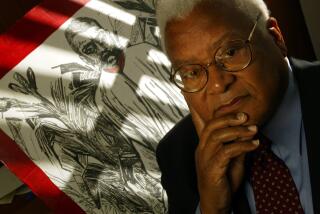PERSPECTIVES ON MARTIN LUTHER KING JR. DAY : The Issues Weren’t Buried With Him : Countless others fought valiantly for civil rights; many are still around and could enlighten us on today’s history.
- Share via
Hollis Watkins, a short, graying man who was one of the foot soldiers of the civil-rights revolution of the 1960s, looked around the classroom at Jackson State University and asked how many of the 50 or so students had ever heard of the Mississippi Freedom Democratic Party. One or two hands went up. How many had heard of Fannie Lou Hamer? A few more hands went up.
This, at a predominantly black university in the capital of Mississippi, in the state where the Freedom Democrats challenged the white power structure, and on a campus where Hamer, one of the movement’s most charismatic leaders, spoke often about the latest federal or state outrage directed at African-Americans. Watkins didn’t blame the students. It’s how they were taught, or what they weren’t taught, he said.
Teachers will burnish the memory of Dr. Martin Luther King Jr., and that is as it should be. But what about the other people, black and white, across the South and into the North, who risked much that many could vote, obtain a decent education and have a fair shot at a good job? Black History Month is coming, and there’s work to be done in the classrooms.
Last fall, I met with a handful of students at the University of Missouri in a class on civil rights and the media. The students--so young, so bright--said that their high school history classes barely touched on the movement that changed America, and then only on Dr. King and his accomplishments. The one African-American in the class knew a bit more about the discrimination that had kept people from voting, schooling and jobs; she had learned this not in school but from her grandparents.
Fannie Lou Hamer is my special obsession, but she, too, like King, was just one part of a vast movement. It was a movement developed through scattered instances of resistance by brave and outraged little groups through the 1920s, ‘30s and ‘40s before it exploded onto the front pages. King had to have followers to accomplish what he did, and in many areas of the South others led.
Joanne Robinson of the Women’s Political Council in Montgomery, Ala., helped organize the famed bus boycott; Amelia Boynton was a mainstay in Selma; Fred Shuttlesworth in Birmingham; Aaron Henry in Clarksdale, Miss., and so on. Bob Moses and Hollis Watkins worked first in McComb, Miss., then in the closed society of the Mississippi Delta; Vernon Dahmer died in Hattiesburg for his civil-rights activity, and Hartman Turnbow had his home torched in rural Holmes County, Miss., only to be arrested himself on the absurd charge that he set the fire.
Some of these people are still alive. Bring them into the classroom. Don’t treat the civil-rights movement as a fossilized relic placed in the mausoleum with King. Talk about the issues that these people raised:
Who has the jobs, the health care, the political power--the money--and who doesn’t.
To be sure, the most creative history teachers already do this. But as educators talk about redesigning curricula, they should to be talking about turning history on its ear. The students in Missouri echoed the thoughts that we’ve all had about the history classes we’ve taken: Every course always started at the beginning, and you were just getting to the good part--the more recent period--when the year ended.
Why not start with now and work back to then? Wouldn’t it be more interesting to students to learn the background to recent events? Might not that hook them on history in a way that the Revolutionary War and the Smoot-Hawley tariff just can’t match?
Of course, that would mean controversy. It would mean coming to terms with events that many of us are still trying to fathom. But it would give young people a voice in the debate over race that rages around them. More important, it would give them information with which to debate. It would show them that a person here, a person there, can make a difference, that history is made by people just like them--in many cases, by people less educated, with greater odds against them.
It would also show them that as great as Martin Luther King Jr. was, his passing did not end the civil-rights movement, because he was but one of its leaders. It would also show them that the issues he raised and Fannie Lou Hamer raised and Hollis Watkins raised are still very much with us.
More to Read
Sign up for Essential California
The most important California stories and recommendations in your inbox every morning.
You may occasionally receive promotional content from the Los Angeles Times.













